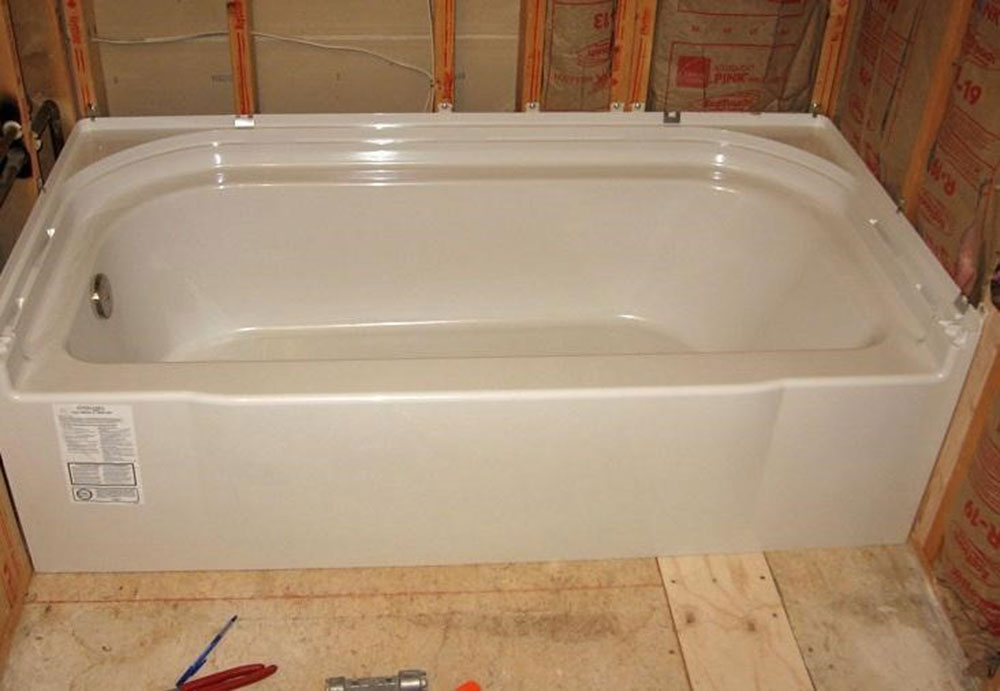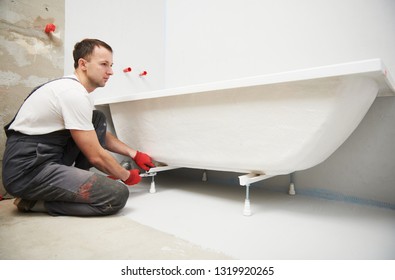Your Plumbing Crash Course: A Necessity for Bathtub Installation
Your Plumbing Crash Course: A Necessity for Bathtub Installation
Blog Article
Just about every person maintains their own individual thinking when it comes to Tools You Need to Install a New Bathtub .

Setting up a bathtub isn't precisely rocket science, but it does require strong plumbing, carpentry, and also occasionally, tiling abilities. Replacing an old bathtub with a new one is additionally a reasonably challenging project. If the old tub is conveniently easily accessible, the project can relocate rapidly; if you have to open up a wall to eliminate the old tub as well as position the new bathtub, the task is a lot harder. In either instance, the task is within a house handyman's skills, although you will certainly require a helper to move out the old bathtub as well as set in the brand-new one. Make certain you have qualified yourself for the work as well as are comfortable trying it. Instead of working with a service provider to take over a halfway-completed job, it is much better to think about using one before you begin. Chances are you may require a professional plumber to make tube connections.
This write-up will aid you install a brand-new bathtub in your shower room if you have already bought a new bathtub and also don't need to transform the setup of your previous water system pipes.
Your tools as well as product list should make up the following:
Removing Old Taps
If you need to replace old taps with new ones as a part of your setup, then the first thing you must do is separate the water. After doing so, activate the faucets to drain any water remaining in the system. The procedure of getting rid of the existing faucets can be rather problematic due to the restricted accessibility that is often the instance.
Make use of a container wrench (crowsfoot spanner) or a tap device to reverse the nut that connects the supply pipelines to the faucets. Have a fabric ready for the continuing to be water that will originate from the pipelines. Once the supply pipelines have been gotten rid of, utilize the very same device to loosen the nut that holds the faucets onto the bath/basin. You will need to quit the solitary faucets from turning during this process. As soon as the faucets have actually been removed, the holes in the bath/basin will have to be cleaned up of any kind of old securing substance.
Prior to moving on to fit the new taps, compare the pipe links on the old faucets to the brand-new faucets. If the old faucets are longer than the new taps, then a shank adapter is required for the new taps to fit.
Suitable New Touches
If the tails of the new taps are plastic, after that you will certainly need a plastic connector to prevent damage to the string. One end of the adapter fits on the plastic tail of the tap and the various other end gives a connection to the existent supply pipelines.
If you require to fit a monobloc, after that you will certainly call for reducing couplers, which links the 10mm pipeline of the monobloc to the typical 15mm supply pipeline.
Next off, place the tap in the mounting hole in the bath/basin making sure that the washers are in area in between the faucet and the sink. Secure the faucet in position with the producer provided backnut. As soon as the tap is securely in position, the supply pipes can be connected to the tails of the faucets. The taps can either be attached by utilizing corrugated copper piping or with normal faucet connectors. The previous kind ought to be attached to the faucet finishes initially, tightening just by hand. The supply pipelines can later on be linked to the other end. Tighten up both ends with a spanner after both ends have been linked.
Installing the Tub
Making use of both wooden boards under its feet, put the bath tub in the called for placement. The wooden boards are helpful in uniformly spreading the weight of the tub over the area of the boards rather than focusing all the weight onto four tiny factors.
The following goal is to make sure that the tub is leveled all round. This can be accomplished by checking the level and adjusting the feet on the tub till the level reviews degree.
To set up taps, fit all-time low of the furthest versatile faucet port to the suitable supply pipeline by making a compression sign up with; after that do the same for the various other tap.
Turn on the water and also examine all joints and also new pipework for leakages and also tighten them if required. Fill the bathtub and likewise check the overflow electrical outlet and also the normal outlet for leakages.
Ultimately, take care of the bathroom paneling as explained in the maker's instruction manual. Tiling and also securing around the bathtub must wait till the bathtub has been used at least once as this will certainly resolve it right into its final position.
Preparing for the Setup
First of all, the supporting frame provided with the bath must be fitted (if needed) according to the maker's instructions. Next, fit the taps or mixer to the tub. When suitable the faucet block, it is essential to ensure that if the tap includes a plastic washing machine, it is fitted between the bathroom and also the taps. On a plastic bathroom, it is additionally practical to fit a supporting plate under the faucets unit to prevent pressure on the bath tub.
Fit the flexible tap ports to the bottom of both taps making use of 2 nuts as well as olives (often supplied with the bathtub). Fit the plug-hole outlet by smearing mastic filler round the sink outlet hole, and then pass the electrical outlet via the hole in the bath. Utilize the nut supplied by the supplier to fit the plug-hole. Examine the plug-hole outlet for an inlet on the side for the overflow pipe.
Next off, fit completion of the adaptable overflow pipe to the overflow outlet. Afterwards, screw the pipeline to the overflow face which need to be fitted inside the bath. Ensure you utilize all of the supplied washers.
Attach the trap to the bottom of the waste electrical outlet on the bath tub by winding the string of the waste outlet with silicone mastic or PTFE tape, and screw on the catch to the electrical outlet. Connect the bottom of the overflow tube in a comparable manner.The bath should now be ready to be suited its last setting.
Tiling Around the Tub
In the area where the bathroom meets the floor tile, it is necessary to secure the accompanies a silicone rubber caulking. This is necessary as the installation can move enough to fracture a stiff seal, causing the water to penetrate the wall in between the bath and also the tiling, causing problems with wetness as well as possible leakages to the ceiling below.
You can select from a range of coloured sealers to assimilate your components and also installations. They are marketed in tubes and also cartridges, and can securing voids approximately a size of 3mm (1/8 inch). If you have a larger space to fill up, you can fill it with twists of drenched paper or soft rope. Remember to constantly fill the tub with water before sealing, to permit the movement experienced when the bathtub is in usage. The sealer can break relatively very early if you do not consider this motion before sealing.
Additionally, ceramic coving or quadrant ceramic tiles can be used to edge the bath or shower tray. Plastic strips of coving, which are easy to use as well as reduce to dimension, are likewise quickly offered on the market. It is recommended to fit the ceramic tiles using water-resistant or water resistant adhesive and cement.
Bathtub Installation
How Important Is A Bathtub To Your Home?
High-quality baths, showers, and other bathroom updates are necessary when considering a smart investment in your home. It’s a room that you go to every day and one that is constantly being used by guests.The bathroom is one of the top trafficked rooms in a home and also one of the most valuable in terms of home resale.
Install Piping Before Tub
You will be using your existing drain and waste vent system, but pipes required include the hot and cold water supply lines and a pipe leading to a shower head. A mixing valve and shower head are also needed. Air chambers may be required.
Position the Tub
Lower the tub into place so that the continuous flange fits against the wall studs and rests on 1’x4' or 2’x4' supports. Anchor the tub to the enclosure with nails or screws inserted through the flanges into the studs.
NOTE: Remember, bathtubs and shower stalls may require support framing. A bathtub filled with water is extremely heavy, so check building codes and framing support before installing the tub.
Assemble Drain Connections
Assemble the bathtub drain connections by connecting the tub overflow with the tub drain above the trap, not beyond it. The trap will have a compression fitting that screws over the arm of the overflow assembly.
Place a Pipe For the Shower Head
First, locate a brass female threaded winged fitting and attach it to a framing support via a screw or a nail. Then run a pipe up the wall for the shower head. Sweat or solder the other side of the brass fitting to the top of the pipe.
Attaching Hot and Cold Water Lines
Attach your water lines for both hot and cold by sweating these directly into the hot and cold ports of the mixing valve. The mixing valve will be how water enters the tub’s system, not by the pipes themselves.
Install the Spout
Extend a piece of 1/2 inch pipe, or whichever length is specified in the manufacturer’s instructions, for the tub spout. Sweat on a male threaded fitting at the end of the pipe or use a brass nipple of the proper length and a 1/2 inch cap.
NOTE: At this point you should have your rough-in plumbing work inspected before proceeding further.
Check For Leaks
Restore the water pressure and check the drain connection and the supply pipes for any sign of leaking.
estore the Bathroom Wall
Replace the wall with moisture-resistant drywall as a base for your wall covering. Seal the joints between the wall and your new tub with silicone caulk as protection against water seepage.
https://www.berkeys.com/2016/12/02/bathtub-installation-dallas/

As a passionate person who reads about Tools You Need to Install a New Bathtub , I think sharing that excerpt was important. In case you enjoyed reading our blog posting if you please remember to pass it around. Thank you so much for taking the time to read it.
Need Help? Hire Us Now! Report this page